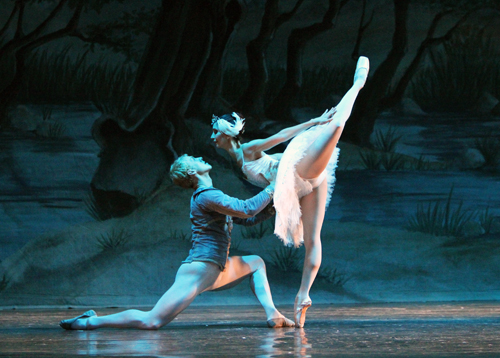
Ana da Costa as Odette and Trystan Loucado as Price Siegfried in City Ballet’s production of Swan Lake. Photo: Chelsea Penyak
By Sheila Orysiek

SAN DIEGO — The first time I saw City Ballet of San Diego was in 2006. The performance was at a less than optimal venue with taped music. The Company was small but the dancing was neat, clean, energetic and full of possibility. On May 11, 2014, a mere eight years later, twenty-four strong dancers (plus apprentices and trainees) confidently took the stage of the classical Spreckels Theatre (the Company’s performing home), with orchestra and chorus. Eight years is a very short a time between the “then” and “now” but a quantum leap of progress.
Ana da Costa and Trystan Loucado danced Swan Lake, Act II, with a fine feeling for the nuances of finding love in an unexpected place. Loucado was a handsome and strong Siegfried and da Costa’s Odette responded. The corps de ballet was smooth, supportive and added the depth necessary for the success of this ballet. In the dance of the Three Big Swans the difficult gargouillades often are a bit muddied, but Megan Jacobs, Kyndra Ricker, and Katie Spagnoletti, made them clearly drawn and easily met the sweep of the music.
In the 1980’s Prima Ballerina Natalia Makarova danced the Grand Pas de Deux in Swan Lake at a much slower tempo than it was normally done and probably slower than the composer, Tchaikovsky, intended when one compares it to how it is performed without dance. While it is not unusual to alter tempo when accompanying dance, still the will of the composer must also be respected.
Makarova explained that she wanted to emphasize the beauty of the choreography and her preferment for the drawn out cantilena style. She was beautiful to watch, but that slow tempo ravaged the music, robbing it of its life and immediacy. The pas de deux as it was danced in Sunday’s performance leaned toward that “Makarova” tempo. It does not take away from the success of the dancers, but from the heart throb of the music.
However, tempo revived and da Costa’s batterie sparkled and when she came to a sudden stop in retiré en pointe – it was a wonderful punctuation of the moment. In the several enchainements traveling diagonally downstage she finished with a beautifully placed arabesque held long enough to fully register but not too long to involve personal ego. Brava for that.
When Von Rothbart, danced by Derek Lauer, appeared, da Costa clearly showed how his presence and his curse upon her was a blow to both her body and her heart. The emotional impact was clearly seen. What was less clearly seen was the contrast between Von Rothbart’s costume color and design and the color and design of the backdrop – it often blended in.
Resident Choreographer Elizabeth Wistrich’s world premiere of “Requiem” to Mozart’s magnificent “Requiem Mass in D Minor” was a challenge well met by the choreographer, dancers, musicians and chorus. The music is so overwhelmingly beautiful – poignant and lyrical – and one is so consumed with what one is hearing, it is difficult at first to open up to another layer of sensation – the music envisioned.
The work is divided into twelve sections each with a costume change; tunics, unitards, simple flowing skirts of differing lengths mostly in various subdued shades of blue, grey, black and white with an occasional touch of color. The back drop was black with a rounded (but not circular) opening raised a few steps up from the stage. This gave the dancers opportunity to enter center stage as well as from the wings.
Part of the design was the use of a scrim; sometimes completely lowered, occasionally halfway up and/or not used. Although a scrim can add another dimension of space, I have never liked the distance it increases from the dancers. In any case, when lowered the bottom border of the scrim is solid and effectively cuts off the feet of the dancers from the line of sight of the audience especially those seated in the orchestra level.
The center stage entry was put to good use especially in the “Lacrimosa” which began with six men seated behind the opening and then with simple but effective movement gave vent to the emotion of this section of the Mass. Geoff Gonzalez and Stephano Candreva then came forward and beautifully completed the mood.
Trystan Loucado in “Hostias” was the realized marvel of a man dancing; man, movement, music were of one piece flowing from line to line and shape to shape – an indelible moment. This was very different than the usual choreographic fodder given to the male dancer of jumps and turns. No, this was dancing as we dream of it.
More and more the men of the Company are in ascendency – taking the stage with power and confidence. They are not effacing the women – but taking their rightful place both with them and as a brotherhood group or as individuals. What a happy future that bodes!
To be fair, I would have to name every dancer who took part in this major undertaking but let me at least name the principals I have not yet mentioned but very much appreciated. Each of them brings unique qualities and yet still blends to one goal: Ariana Samuelsson, Erica Alvarado, Ryosuke Ogura.
Kudos to the chorus and its soloists: Kimberly Hendrix, Garrett Harris, Sharmay Musacchio and Michael Blinco.
Kudos to the orchestra and solo violinist (Swan Lake) under the leadership of John Nettles.
And to the two beautiful Borzois used in the opening scene of Swan Lake – a nice touch.
As for the notes provided in the program…… For both ballets the notes could use the polish of a facile pen and/or a change of word sequence such as: “The mass requiem” to “The Requiem Mass,” etc. Picky, I know.
*
Sheila Orysiek is a freelance writer specializing in coverage of the arts. She may be contacted at sheila.orysiek@sdjewishworld.com